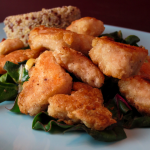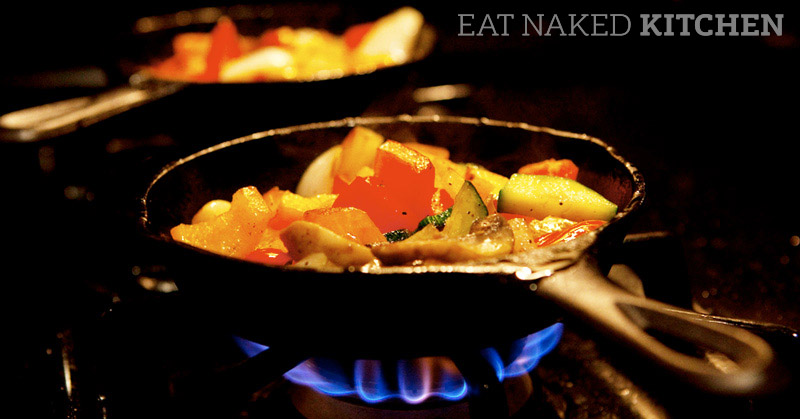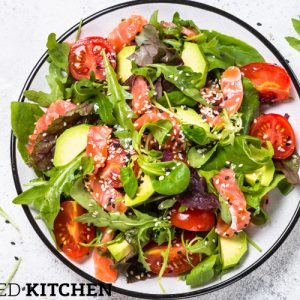
Written by Chef James Barry
We talk a great deal about wheat, gluten, and learning to live a gluten-free lifestyle. With the massive increase in the number of people who are sensitive to this wheat protein, it’s becoming essential to learn where it hides and how to cook without it.
We all know that bread has gluten in it, but I bet you didn’t realize many savory foods – from salad dressings to meatballs – have it hiding in unusual places. As a result, it can be very challenging to eat gluten-free if you’re not making food from scratch. Fortunately, you have a wonderful tool at your fingertips, The Naked Foods Cookbook.
Besides the fact that the entire cookbook is gluten-free, our goal was to make recipes that were easy and delicious, without all the fillers and starches you find in most commercially-prepared gluten-free products.

When cooking I find that it helps to have a clear starting point and end vision of the finished recipe. With gluten-free cooking, you’ll want to have some awareness of the way the dish is made traditionally. For example, fried chicken is dusted in flour, meatballs are mixed with breadcrumbs, and gravy is made with cornstarch or flour.
Once you have an idea of the traditional cooking technique, next you’ll want to think about the texture or consistency you want to experience when eating the dish. With fried chicken, it’s not necessarily the flour we are so invested in, but more the crunchy outside and the juicy inside. We add breadcrumbs to meatballs and meatloaf for moisture and texture. We use cornstarch or flour to thicken the gravy.
Knowing the purpose of the wheat in the dish helps to inform what we replace it with:
- instead of flour for the crispy outside of the fried chicken, we use nuts and seeds to recreate that desired crunch (without the deep-frying!)
- instead of breadcrumbs, we use a mix of walnuts and zucchini to provide the moisture, texture, and more veggies to our meatballs
- instead of flour or cornstarch, we use arrowroot to thicken gravy
 Here’s a great process we use frequently for reproducing that crispy crunchy outside of deep-fried chicken (or fish, or whatever protein you like). This is easily recreated using just about any combination of nuts and/or seeds.
Here’s a great process we use frequently for reproducing that crispy crunchy outside of deep-fried chicken (or fish, or whatever protein you like). This is easily recreated using just about any combination of nuts and/or seeds.
- When you’re making a nut crust, you need something to make the nuts stick. We like to use egg, mustard, a healthy, stable fat (melted ghee, coconut oil, etc.) or even water. Place the meat or fish in the liquid so it is soaking while you prepare the nuts mixture.
- Using a food processor, place the nuts and/or seeds into the container. Add some fresh or dried herbs, salt and other seasonings and pulse the food processer until the mixture is to your desired consistency. You want the mixture to be fairly dry or it won’t stick to the protein well. To keep the mix dry, use dried herbs and spices (granulated garlic instead of fresh garlic for example). Empty the mixture into a separate bowl or shallow dish.
- Now you’re ready to assemble your crispy chicken. Make sure to shake as much of the liquid off the meat before dredging it in your nut mix. If too much liquid gets into your nut mix, it will get clumpy.
- Did you preheat your oven? One of the benefits of eating gluten-free is also not deep-frying your food. Baking is far healthier, and will still create that desired crunch. Just make sure to keep a sharp eye on your food while it’s baking since nuts and seeds burn easily.
Below is a recipe from The Naked Foods Cookbook for our gluten-free nut crust.
Nut Crust
Yield: 2 1/2 cups
Ingredients:
1 cup almonds, ideally pre-soaked and dehydrated or slow-roasted
1 cup pumpkin seeds or pepitas, ideally pre-soaked and dehydrated or slow-roasted
1/2 cup parsley
1 tablespoon granulated garlic
1 teaspoon sea salt
1 teaspoon paprika
1/2 teaspoon ground black pepper
1 tablespoon grated parmesan (optional)
Directions:
Combine all ingredients in a food processor and pulse several times until nuts are chopped. Store in the fridge in a sealed container until ready to use.
For more easy and delicious gluten-free recipes, get your own copy!
The Naked Foods Cookbook is available at most major bookstores,
Amazon, and Barnes & Noble.com.





Thanks James for the great information and recipe.
Thanks for the tip of using zucchini and walnuts instead of breadcrumbs in my meatballs!
Sure thing! If yo’re cooking for someone sensitive to walnuts, just substitute the walnuts with a seed. I’ve used the pepita dairy-free pesto (in the Naked Foods Cookbook) mixed in my meatballs before to great effect.
Hi James,
I love the idea of all these recipes, but what should one use in place of nuts. I have a severe allergy to peanuts and almonds and a moderate allergy to all other nuts. I have to carry two epi pens with me at all times. Ideas on what I can substitute?
Thanks!
Rosa (from the yoga naga days)
Hi Rosa! Great to see you on this site and hear from you! I hear you, lots of people are allergic or sensitive to nuts. I recommend substituting with seeds. Instead of almonds, use pepitas (or pumpkin seeds). For the green smoothie in The Naked Foods Cookbook, instead of cashews, use presoaked chia seeds. Instead of peanuts, use sunflower seeds. It’s a different taste, but still good none-the-less.